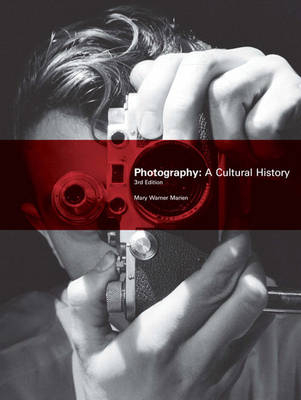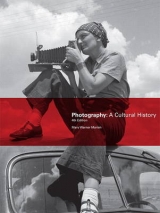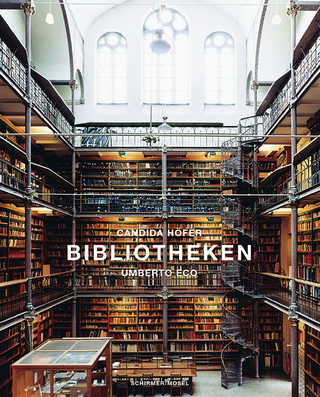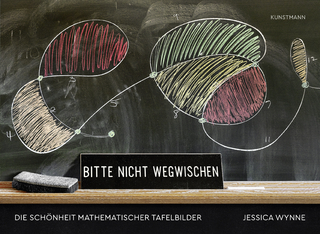
Photography
Pearson (Verlag)
978-0-205-70800-0 (ISBN)
- Titel erscheint in neuer Auflage
- Artikel merken
Mary Warner Marien has constructed a richer and more kaleidoscopic account of the history of photography than has previously been available. Her comprehensive survey shows compellingly how photography has sharpened, if not altered forever, our perception of the world.
The book was written to introduce students to photography. It does not require that students possess any technical know-how and can be taught without referring to techniques in photography. Incorporating the latest research and international uses of photography, the text surveys the history of photography in such a way that students can gauge the medium's long-term multifold developments and see the historical and intellectual contexts in which photographers lived and worked. It also provides a unique focus on contemporary photo-based work and electronic media.
Mary Warner Marien is a professor in the Department of Fine Arts at Syracuse University New York where she teaches courses on photographic history as well as on art criticism and its history. In 2008 she won an Andy Warhol Foundation Arts Writer award for her continuing work on the history and theory of documentary photography and is the author of 'Photography and its Critics' (Cambridge University Press, 1997) as well as numerous articles on the history of photography.
Preface X
Introduction XIII
Part One
Photography’s Double Invention 1
Chapter One
The Origins of Photography (to 1839) 3
Before Photography 4
Technological and Artistic Forebears 4
The Invention of “Photographies” 7
Antoine Florence and the Question of Simultaneous Invention 7
Focus: The First Photograph 8
The Problem of Permanence: Wedgwood and Davy 9
The “Sun Writing” of Niépce 10
The Collaboration of Niépce and Daguerre 12
Daguerre and the Latent Image 13
Responses to the Announcement of the Daguerreotype 16
Bayard’s Direct Positive Process 16
Herschel’s “Photographic Specimens” 17
Focus: The Stranger 18
Talbot’s Photogenic Drawing 19
The Politics of Invention 22
Retake 23
Chapter Two
The Second Invention of Photography (1839— 1854) 25
The Second Invention 25
Focus: Iron, Glass, and Photography 29
Talbot and The Pencil of Nature 30
Bayard: The Doubting Camera 31
Photography and the Sciences 32
The Microscope and the Telescope 32
Biology 34
Anthropology and Medicine 35
Focus: Photography, Race, and Slavery 38
Performing History? The Dr. Morton Controversy 39
Recording Events with the Camera 40
War and Photography 43
Imaging War 43
Focus: The Mexican—American War 44
British Conflicts in Asia 45
Expeditionary and Travel Photography 46
Egyptand the Holy Land 46
The Historic Monuments Commission 52
Portraiture and the Camera 58
Coloring the Image 61
The Photography Studio 62
Celebrity Photography 65
The Firm of Southworth and Hawes 66
The Calotype Portrait: Hill and Adamson 66
Focus: The First Police Pictures? 70
The Reality Effect 71
Photography and Fiction 71
Retake 73
Philosophy and Practice: A Threat to Art? 74
Part Two
The Expanding Domain (1854—1880) 76
Chapter Three
Popular Photography and the Aims of Art 79
Photographic Societies, Publications, and Exchange Clubs 79
The Stereograph 80
The Carte-de-Visite 83
Art and Photography 83
Art Reproduction 83
Photography as a Fine Art 84
High Art Photography 87
Focus: Lewis Carroll’s Photographs of Children 91
Women Behind the Camera 92
Women as Amateurs 92
Portrait: Julia Margaret Cameron 94
Women as Professionals 96
Retake 97
Chapter Four
Imaging of the Social World 99
War and Photography 99
The Crimean War 100
Roger Fenton 100
Focus: The Valley of Death 101
James Robertson and other Crimean Photographers 103
The American Civil War 104
The Effect of the War on Photography 105
Portrait: Mathew Brady 106
Portrait: Alexander Gardner 110
The Civil War and Remembrance 112
Later Conflicts 113
The War of the Triple Alliance, South America 113
The Franco—Prussian War and the Paris Commune 114
“Small Wars,” Colonial Expansion, and Photography 116
India117
China120
Japan124
Photography in the Middle East 126
Topographical Surveys and Photography 127
The Abyssinian Campaign, or the Magdala Expedition 129
Désiré Charnay and Expeditionary Photography 129
The 49th Parallel Survey 130
Government Surveys in the United States 131
Photography and the Transcontinental Railway 132
Timothy O’Sullivan and Survey Photography 133
Preservation of the Wilderness: Yellowstone and Yosemite 134
War and the Photography of Native Americans 138
The Modoc War 138
The Fort Laramie Treaty 140
Little Big Horn 141
Retake 141
Chapter Five
Science and Social Science 143
Photography and the Social Sciences 143
Ethnographic Studies and Display 143
Orientalism 145
“Dying cultures” 147
Popularizing Ethnic and Economic Types 148
Photographic Studies of Human Expression 151
Duchenne de Boulogne 152
Darwin153
Charcot 154
Photography in Medicine and Science 154
Photomicrography and Astronomical Photographs 156
Retake 159
Philosophy and Practice: “Superseded by Reality” 160
Part Three
Photography and Modernity (1880—1918) 162
Chapter Six
The Great Divide 165
Mass Media and Mass Markets 165
“You press the button—We do the rest” 168
The Postcard Craze 169
The Challenge for Art Photography 170
Naturalistic Photography 170
Pictorialism 172
Movements and Magazines 174
The Photo-Secession 181
Portrait: Alfred Stieglitz 182
Portrait: Edward Steichen 184
The Nude and Pictorialism 187
Women in the Pictorialist Movement 188
Portrait: Gertrude Käsebier 190
Anthropological Pictorialism 193
Non-Pictorialist Visions 195
Pictorialism: A Conservative Avant-Garde 196
Retake 201
Chapter Seven
Modern Life 203
The Modern City 203
Social Reform Photography 204
Portrait: Jacob Riis 206
Portrait: Lewis Hine 207
The Ideal City 209
Science and Photography 210
The Photography of Movement 210
Focus: Photography and Futurism 212
Photography and the Invention of Moving Pictures 214
The X-Ray 214
Focus: Worker Efficiency: The Gilbreths’ Time and Motion Studies 215
Photography, Social Science, and Exploration 216
Photographing Africa 217
Focus: The National Geographic 219
Photographing the Pacific Paradise: Samoa 220
Criminal Likenesses 220
War and Revolution 224
The Spanish—American War 224
World War I 226
The Russian Revolution 228
Retake 229
Philosophy and Practice: The Real Thing 230
Part Four
A New Vision (1918—1945) 232
Chapter Eight
Art and the Age of Mass Media 235
Photojournalism 235
Revolutionary Art: The Soviet Photograph 238
Dada and After 242
Moholy-Nagy and the Bauhaus 245
Focus: Photomontage or Photocollage 246
Paris—Berlin—Prague 249
Dada and Paris 249
Dada and the Machine Age in New York 250
Surrealist Photography 253
Experimental Photography and Advertising 260
Focus: Film and Photography 262
Experimental Photography as Style 265
California Modern 268
Retake 277
Chapter Nine
Social Science, Social Change, and the Camera 279
The Origins of Documentary 279
The Farm Security Administration 280
Portrait: Margaret Bourke-White 286
Other Documents 288
Transforming the Social Documentary 289
Portrait: August Sander 291
Worker Photography 292
Popular Science/Popular Art 296
World War II 299
War and Photography 302
Retake 308
Philosophy and Practice: The “Common Man” and the End of Media Utopia 309
Part Five
Through the Lens of Culture (1945—1975) 310
Chapter Ten
The Human Family 313
The Family of Man 313
Cultural Relativism and Cultural Resistance 314
Focus: Making an Icon of Revolution 316
Central and South America 317
Braziland Argentina 320
Mexico321
Africa323
Portrait: Manuel Álvarez Bravo 324
Asia328
India328
Japan330
Photographing the Atomic Bomb 332
Portrait: Shomei Tomatsu 334
Retake 337
Chapter Eleven
The West and the Cold War 339
Annihilation, Alienation, Abstraction: America 341
The Americans 344
On the Streets 347
The Social Landscape 349
Suburbia 354
Technology and Media in Postwar America 358
Color Photography and the Polaroid Process 358
Television, Photojournalism, and National Events 364
Photography in Art 372
The Czar’s Pantheon 383
Retake 389
Philosophy and Practice: Purity and Diversity 390
Part Six
Convergences (1975 to the Present) 392
Chapter Twelve
Globalism, Technology, and Social Change 395
Photography and the Global Experience 395
Photography, Nature, and Science 401
Post-Photography 405
The End 405
Everything Old is New Again 407
Face Value 415
The Predicaments of Social Concern 416
The Color of Concern 422
Neutral Vision 423
Portrait: Sebastião Salgado 426
Focus: The Cambodian Genocide Photographic Database 433
The Look of Politics 434
Retake 435
Chapter Thirteen
The Postmodern View 437
The New Social Documentary 437
Thinking Photography 441
The Postmodern Era 442
Postmodernist Photography 443
Art Photography and Photography-by-artists 444
Blurring the Subject 445
Feminism and Postmodern Photography 450
Constructed Realities 452
Focus: Culture Wars 454
Family Pictures 462
Extended Family 466
Focus: Looking at Children 474
Nature and the Body Politic 477
Enter Fashion 486
The Passing of Postmodernism 490
Retake 491
Chapter Fourteen
Into the Twenty-First Century 493
War and Photography 493
The Space and Time of Memory 494
Soldiers 494
The Past in the Present 497
Slide Shows 497
Screens 498
The Medium of the Moment 498
Photographic Practice and Globalization 503
Global/Local 505
The Arab World 507
Focus: China508
Youth and Beauty 510
Science and Society 513
The Animal Kingdom 514
Screens and Platforms 516
Retake 517
Philosophy and Practice: Re-Membering 518
Epilogue 519
Glossary 520
Picture Credits 524
Timeline 526
Notes 531
Bibliography 541
Index 545
| Erscheint lt. Verlag | 29.4.2010 |
|---|---|
| Sprache | englisch |
| Maße | 293 x 218 mm |
| Gewicht | 1740 g |
| Themenwelt | Kunst / Musik / Theater ► Fotokunst |
| ISBN-10 | 0-205-70800-5 / 0205708005 |
| ISBN-13 | 978-0-205-70800-0 / 9780205708000 |
| Zustand | Neuware |
| Haben Sie eine Frage zum Produkt? |
aus dem Bereich



